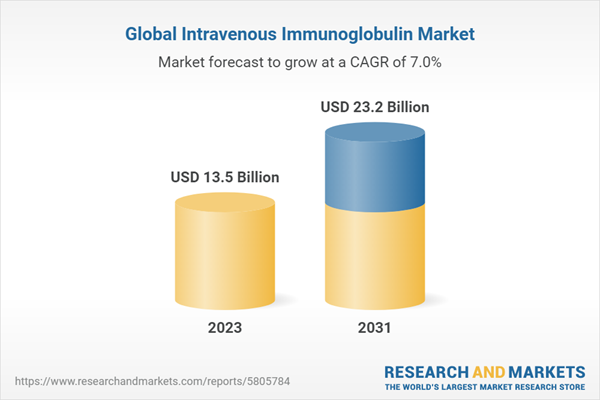Introduction
Intravenous Immunoglobulin (IVIG) is a therapeutic preparation that contains concentrated antibodies derived from human plasma. It is administered intravenously to provide passive immunity and immune modulation in individuals with immune deficiencies and autoimmune disorders. IVIG is derived from pooled plasma donations and undergoes a series of purification and viral inactivation processes to ensure its safety and efficacy.IVIG therapy has been widely used in various medical conditions, including primary immunodeficiencies, autoimmune diseases such as immune thrombocytopenia and Guillain-Barré syndrome, and certain neurological disorders like chronic inflammatory demyelinating polyneuropathy. It works by supplementing or modulating the immune system, providing a broad spectrum of antibodies to target pathogens or autoantibodies, and modulating the immune response.
Key Trends in the Intravenous Immunoglobulin Market
Some key trends involved in the Intravenous Immunoglobulin market are as follows:- Increasing demand and usage: The demand for IVIG therapy is on the rise due to the growing prevalence of immune deficiencies and autoimmune disorders. As more conditions are being recognized and diagnosed, the need for IVIG as a treatment option is increasing
- Expansion of indications: IVIG therapy is being explored and utilized in a broader range of medical conditions beyond its traditional use. This includes neurological disorders, dermatological conditions, and certain inflammatory and autoimmune diseases. The expansion of indications is driving the growth of the IVIG market
- Advancements in manufacturing and purification techniques: Manufacturers are investing in research and development to improve the manufacturing process and purification techniques for IVIG products. This includes enhanced viral inactivation methods, increased product safety, and improved yield from plasma donations. These advancements contribute to the quality and availability of IVIG products
- Personalized medicine and dose optimization: There is a growing emphasis on personalized medicine in IVIG therapy. Healthcare providers are exploring ways to tailor IVIG treatment to individual patients based on factors such as their specific condition, response to therapy, and optimal dosing. This approach aims to improve treatment outcomes and patient satisfaction
Intravenous Immunoglobulin Market Segmentations
Market Breakup by Type
- IgG
- IgM
- IgA
- IgE
- IgD
Market Breakup by Applications
- Hypogammaglobulinemia
- CIDP
- Immunodeficiency Diseases
- Congenital AIDS
- Chronic Lymphocytic Leukemia
- Myasthenia Gravis
- Multifocal Motor Neuropathy
- ITP
- Kawasaki Disease
- Guillain-Barre syndrome
- Others
Market Breakup by Route of Administration
- Intravenous
- Subcutaneous
Market Breakup by End User
- Clinics
- Hospitals
- Specialty Clinics
- Others
Market Breakup by Distribution Channel
- Hospital Pharmacy
- Retail Pharmacy
- Online Pharmacies
- Others
Market Breakup by Region
North America
- United States of America
- Canada
Europe
- United Kingdom
- Germany
- France
- Italy
- Others
Asia Pacific
- China
- Japan
- India
- ASEAN
- Australia
- Others
Latin America
- Brazil
- Argentina
- Mexico
- Others
Middle East and Africa
- Saudi Arabia
- United Arab Emirates
- Nigeria
- South Africa
- Others
Intravenous Immunoglobulin Market Scenario
The market for Intravenous Immunoglobulin (IVIG) is a rapidly growing and evolving segment of the healthcare industry. IVIG therapy involves the administration of concentrated antibodies derived from human plasma to treat various immune deficiencies and autoimmune disorders. It plays a crucial role in providing passive immunity and immune modulation to patients.The market for IVIG is primarily driven by the increasing prevalence of immune-related disorders, such as primary immunodeficiencies, autoimmune diseases, and neurological disorders. The growing recognition and diagnosis of these conditions, coupled with advancements in diagnostic techniques, have contributed to the rising demand for IVIG therapy.
The market is also influenced by factors such as increasing healthcare expenditure, the growing geriatric population, and the rise in chronic diseases worldwide. Additionally, the development of biosimilar versions of IVIG products has introduced competition, leading to cost-effective options for patients and healthcare providers.
Intravenous Immunoglobulin Market: Competitor Landscape
The key features of the market report include patent analysis, grants analysis, clinical trials analysis, funding and investment analysis, partnerships, and collaborations analysis by the leading key players. The major companies in the market are as follows:- Baxter
- Bayer AG
- Merck & Co., Inc
- Biotest AG
- Top Bio Group Co., Ltd
- CSL Limited
- Octapharma AG
- Grifols, S.A
- Kedrion S.p.A
- Shanghai RAAS Blood Products Co., Ltd
Table of Contents
Companies Mentioned
- Baxter
- Bayer AG
- Merck & Co. Inc.
- Biotest AG
- Top Bio Group Co. Ltd.
- CSL Limited
- Octapharma AG
- Grifols
- S.A.
- Kedrion S.p.A
- Shanghai RAAS Blood Products Co. Ltd.
Table Information
| Report Attribute | Details |
|---|---|
| No. of Pages | 140 |
| Published | May 2023 |
| Forecast Period | 2023 - 2031 |
| Estimated Market Value ( USD | $ 13.5 Billion |
| Forecasted Market Value ( USD | $ 23.2 Billion |
| Compound Annual Growth Rate | 7.0% |
| Regions Covered | Global |
| No. of Companies Mentioned | 11 |









